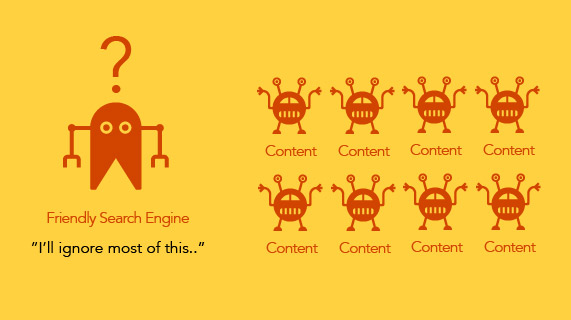Making sense of duplicate content
Reading Time: 3 minutesFor some of you the subject might already be very familiar, especially if you are trying to improve your SEO strategy.
Yes, search engines such as Google have a huge problem with duplicate content. It is a surprise that even though some marketers may acknowledge this, they are focused on short term results and do not realize the ramifications long term and what incredibly damaging effects can occur!
So what is ‘duplicate content’? Essentially, it is as the title describes, content throughout your website that is showing on multiple pages. Why is it a problem? Well, think of it from a logical point of view – for our analogy we will use a room full of oranges. You (the search engine) need to decide which orange to take, but the problem is they are all identical. Okay, maybe not the best analogy, but in technical terms search engines will not know what pages should be indexed or excluded. Similarly, you can be sure that sites will suffer ranking issues and loss of targeted content.
What can be done?
Some duplicate content unfortunately may not even be known about or perhaps is an area that was missed in a preliminary release to the online market. Rather than diving into all of the technical scripts and solutions, time4design has created a short list of what should be covered. An experienced SEO developer will have the know-how on its execution.
1: Avoid Duplicate Content
This may be the most obvious, but ensure there are no pages with the same exact content. It is especially useful to know that content should not be present on other websites as well. In the past, this has been the thought of a SEO gain, but of course it really is not and search engines cannot be fooled. For some websites the fault may be purely unintentional but for others re-purposed material can incorrectly link to the original.

2: Printer Friendly Pages
The architecture of some websites might hold duplicate pages designed to be ‘Printer Friendly’. Pages that have a separate layout designed for a clean layout unfortunately might having damaging results, therefore it is important to add ‘nofollow links’ to prevent pages from becoming indexed.
3: URL Parameters
This is perhaps more technical, but in some cases dynamic links might be created by the website that leads into creating 10 or more URL’s. Although content might not be duplicative (for example, one page of content that exists only), it is being retrieved multiple times.
4: Session ID’s
Quite common in creating duplicate content based on the functionality of the website, a visitor may need to be assigned a session ID to be passed on within the URL.
5: WWW or http?
Which is it? ‘www’ or no ‘www’? Why is https and http both indexed? At times both versions can easily be indexed, so it’s important to make sure that this upon launch is not missed. Pick one and remain with that option, the other can easily be redirected.
6: Meta tags
Having duplicate metatags will run you into further trouble. Metatags should in no circumstances be duplicative across pages, and contain information that is relative to the page. In this case, we recommend Google Webmaster tools that can help with HTML suggestions and identify common problems.
Duplicate content is a well discussed subject, so it’s worth researching and understanding what can be done to best improve your SEO. A majority of websites do have common issues with content, so it good to have an experienced SEO specialist and developer analyze what is effective for your website. A great start is to hire time4design for a full investigation!
